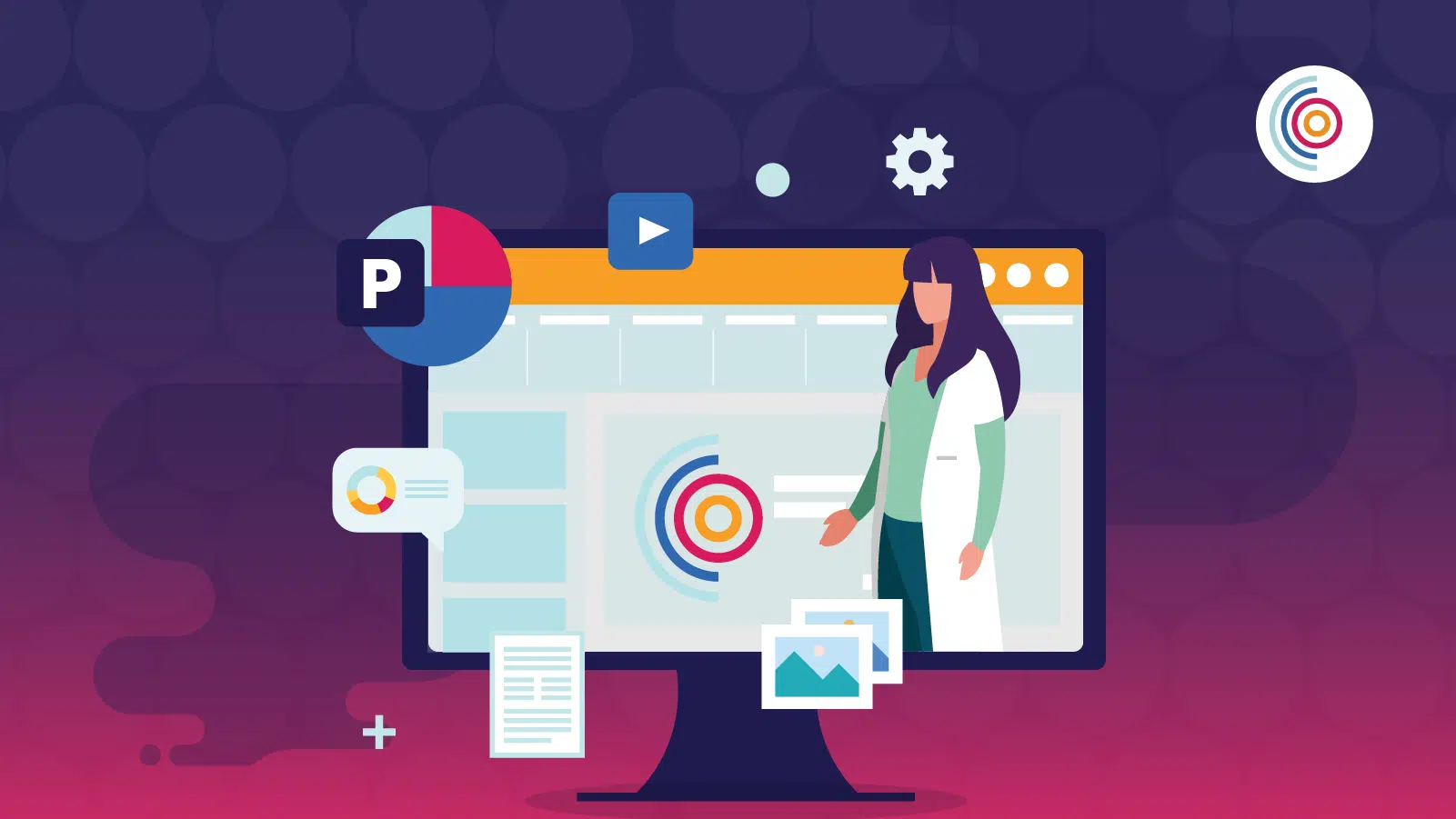In the fast-paced and critical world of healthcare, your ability to effectively communicate information through presentations is indispensable. Whether you’re addressing colleagues, stakeholders, or policymakers, the impact of your presentation can influence patient care, funding decisions, and even public health policies.
This blog explores the essential elements necessary for creating powerful healthcare presentations that are informative, persuasive, and engaging. You’ll gain insights into crafting presentations that demonstrate your expertise and adaptability while fostering a collaborative approach. By focusing on clarity and incorporating industry-specific language, you’ll ensure your message resonates with your audience and instills trust and assurance.
Effective presentation design in healthcare serves several pivotal purposes:
- Clarity: Healthcare presentations often involve complex medical data and concepts. A clear and concise presentation design ensures that your audience can easily understand and interpret the information, facilitating informed decision-making.
- Persuasion: When pitching a new medical service, presenting research findings, or advocating for policy changes, your presentation needs to persuade your audience of the importance and benefits of your proposal. Visuals and narratives play a crucial role in this persuasion process.
- Engagement: Keeping your audience engaged is essential for maintaining their focus and enhancing their retention of key information. Interactive elements and compelling storytelling significantly contribute to audience engagement during healthcare presentations.
By integrating these principles into your presentation strategy, you can effectively communicate your message while building trust and confidence among your audience. This approach ultimately drives positive outcomes in the healthcare sector.
Essential Elements of Effective Healthcare Presentations
To create presentations that truly resonate and achieve their intended goals, you should concentrate on the following critical elements:
- Clear Objectives: Every impactful presentation starts with a clear objective. Define what you aim to achieve—whether it’s to educate your audience, persuade them to adopt a new treatment approach or secure funding for a research project. Clearly outlining your objectives will guide the content and structure of your presentation.
- Compelling Visuals: Visual aids are indispensable for simplifying complex information and enhancing audience understanding. Key visuals include:
- Charts and Graphs: Illustrate trends, clinical trial outcomes, or epidemiological data in a visually compelling manner.
- Infographics: Summarize key statistics or processes in a concise and visually appealing format.
- Images and Videos: Provide concrete examples, demonstrate medical procedures, or showcase patient success stories to make the presentation more relatable and impactful.
- Cohesive Storytelling: Structure your presentation like a narrative to maintain audience interest and effectively convey information. A well-structured presentation typically includes:
- Engaging Introduction: Capture your audience’s attention from the outset with a compelling introduction that sets the stage for what follows.
- Logical Flow: Present key points in a coherent sequence that builds upon each other, leading to a clear conclusion.
- Strong Conclusion: Summarize your main points succinctly and reinforce your message to leave a lasting impression on your audience.
- Tailored Content: Understand your audience’s background, knowledge, and specific interests. Tailor your content accordingly, using appropriate medical terminology while ensuring clarity for those who may not be healthcare specialists. By adapting the complexity of your presentation to match the audience’s level of expertise, you enhance understanding and engagement.
- Interactive Elements: Incorporate interactive elements to actively engage your audience during the presentation. Examples include:
- Q&A Sessions: Allow for questions and answers to address specific concerns or queries from your audience.
- Polls or Surveys: Gather feedback or opinions on critical issues related to your presentation topic.
- Discussions or Workshops: Facilitate group discussions or workshops to explore ideas or solutions collaboratively.
Interactive elements not only enhance engagement but also provide opportunities for real-time feedback and clarification, fostering a more dynamic and participatory presentation environment.
7 Effective Design Principles for Your Healthcare Presentations
Design is crucial in making your healthcare presentations not only visually appealing but also effective in conveying your message. Here are key design principles to enhance your presentations:
- Simplicity: Keep your slides clean and uncluttered. Avoid overcrowding with excessive text or images. Aim for minimalism, ensuring each slide communicates one key idea.
- Consistency: Use a uniform design theme throughout your presentation. Consistent fonts, color schemes, and layouts maintain a professional look and make your presentation easier to follow.
- Readable Fonts: Choose fonts that are easy to read, even from a distance. Sans-serif fonts like Arial or Helvetica are often preferred. Adjust font sizes to ensure all text is legible, with larger sizes for headings and smaller, but still readable, sizes for body text.
- Color Theory: Utilize color to highlight key points and create visual contrast. Stick to a coherent color palette that aligns with your content and is accessible to those with color blindness.
- Visual Hierarchy: Establish a clear visual hierarchy to guide your audience’s attention. Use size, color, and placement to indicate the importance of different elements. Make headlines prominent, while supporting text can be smaller.
- High-Quality Visuals: Integrate high-quality images, charts, and infographics. Ensure all visuals are directly relevant to your content and enhance understanding.
- Whitespace: Use whitespace effectively to add breathing room and avoid overwhelming your audience. Whitespace creates a balanced, aesthetically pleasing design that improves readability.
Adhering to these design principles will make your healthcare presentations more engaging and effective, aiding your audience in better comprehension and retention of information.
Practical Tips for Enhancing Healthcare Presentations
To elevate the effectiveness of your healthcare presentations, consider the following expert strategies:
- Seek Expert Collaboration: Working with professional presentation designers who specialize in healthcare can significantly enhance your presentation’s impact. Their expertise in visual communication and storytelling ensures your slides are visually appealing, your content structure is refined, and your narrative is coherent. This collaboration highlights your commitment to excellence and precision.
- Commit to Continuous Improvement: It is crucial to regularly update and refine your presentation materials based on feedback, new data, or evolving audience needs. By incorporating the latest information, you ensure relevance and boost the credibility of your message. This practice not only keeps your presentations current but also demonstrates your dedication to staying at the forefront of your field.
- Maintain Consistent Branding: Ensure all presentation materials consistently reflect your brand, including colors, fonts, logos, and formatting. Consistent branding reinforces your professional identity, building familiarity and trust with your audience. A cohesive visual identity reflects your organization’s professionalism and meticulous attention to detail.
Engaging Storytelling Techniques
Incorporating storytelling into your healthcare presentations can significantly enhance audience engagement and information retention. Stories captivate, making complex data relatable and easier to understand. Here are some techniques to effectively integrate storytelling:
- Start with a Hook: Begin with a compelling anecdote or case study that underscores your topic’s importance. This approach will draw your audience in and set the stage for the information to follow.
- Use Patient Journeys: Illustrate points through patient journeys. Walking your audience through a patient’s experience, from diagnosis to treatment, humanizes the data and makes abstract concepts more tangible.
- Incorporate Visual Narratives: Use images, charts, and videos to complement your story. Visual aids break down complex information and keep your audience visually engaged.
- Highlight Real-World Impact: Share success stories, lessons learned, or case studies to showcase the real-world implications of your data or findings. This will add depth to your presentation and emphasize the practical significance of your work.
- Balance Data with Empathy: While quantitative data is essential, balancing it with empathetic storytelling highlights the human aspect of healthcare. This dual approach connects emotionally with your audience while maintaining credibility.
By mastering these storytelling techniques, you can transform your healthcare presentations from mere data dissemination sessions into powerful narratives that leave a lasting impact on your audience.
Elevate Your Healthcare Presentations with Our Expert Assistance
Effective presentation design is a critical asset in the healthcare industry, shaping decisions, driving innovations, and promoting positive outcomes. By focusing on clarity, compelling visuals, cohesive storytelling, tailored content, and interactive engagement, healthcare professionals can craft presentations that not only impress but also persuade and achieve success.
To enhance your presentations and make a significant impact in healthcare, consider partnering with Conway Marketing Group. Our expertise in presentation design and marketing services ensures you create persuasive presentations that resonate with your audience and drive success in your field. Contact Conway Marketing Group to discover how we can elevate your healthcare presentations.



